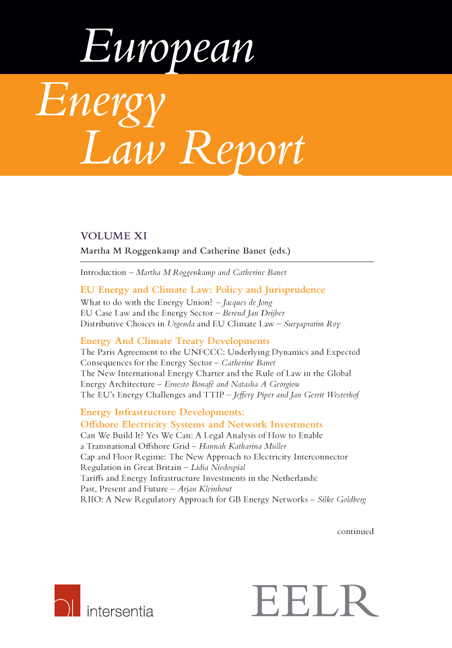Book contents
- Frontmatter
- Editorial
- Contents
- List of Abbreviations
- List of Contributors
- Introduction
- Part I EU Energy and Climate Law: Policy and Jurisprudence
- Part II Energy and Climate Treaty Developments
- Part III Energy Infrastructure Developments: Offshore Electricity Systems and Network Investments
- Part IV Heat Supply Legislation in the Eu
- Part V Security of Energy Supply and Safety
- Chapter XIV Shale Gas and the EU
- Chapter XV Reducing Gas Production from the Groningen Field: The Need to Balance Safe Production with Supply Security
Chapter XV - Reducing Gas Production from the Groningen Field: The Need to Balance Safe Production with Supply Security
from Part V - Security of Energy Supply and Safety
Published online by Cambridge University Press: 29 September 2018
- Frontmatter
- Editorial
- Contents
- List of Abbreviations
- List of Contributors
- Introduction
- Part I EU Energy and Climate Law: Policy and Jurisprudence
- Part II Energy and Climate Treaty Developments
- Part III Energy Infrastructure Developments: Offshore Electricity Systems and Network Investments
- Part IV Heat Supply Legislation in the Eu
- Part V Security of Energy Supply and Safety
- Chapter XIV Shale Gas and the EU
- Chapter XV Reducing Gas Production from the Groningen Field: The Need to Balance Safe Production with Supply Security
Summary
INTRODUCTION
Although smaller earthquakes have been registered in the province of Groningen since 1986, their magnitude was usually quite small and therefore their impact negligible. However, since 2006 the number of earthquakes in the province of Groningen has increased, as well as their intensity, which reached 3.6 on the Richter scale in 2012. These earthquakes occur at approximately 3km below the surface, where the gas reservoirs are situated, and have resulted in considerable damage to properties, which sometimes was so severe that it was deemed necessary to demolish houses and rebuild them.
The increase in the number of heavier earthquakes has also led to a new attitude towards the production of natural gas in the province of Groningen. After 50 uneventful years of gas production, the opinion of the local population towards the production activities and the gas producer NAM drastically changed. Instead of accepting the activities and some of its benefits (such as employment), the population turned against the gas producer NAM and the national Government, which had allowed for the production activities but at the same time had not taken sufficient measures to protect the local population from any adverse effects. This resulted in increasing mistrust and skepticism by the local community towards the Government. The latter is now charged with regaining the trust of citizens, which has resulted in the introduction of new agencies and governance structures but also in a drastic decrease in the production of gas from the Groningen field.
This chapter will present the background of the gas production in Groningen and the legal framework applying to it. It will then discuss the effect of the earthquakes and provide an overview of the impact this has on production, the way in which the population is compensated and the launch of some new governance structures. As noted, the historical and policy background will be discussed first as decisions made when the gas field was discovered still play a role in the current decision-making process.
DEVELOPING THE GRONINGEN GAS FIELD
POLICY BACKGROUND
The discovery of the Groningen gas field in 1959 posed a challenge for the Dutch Government. Whereas the field proved to be one of the largest in Europe, the gas supply market was fragmented and regional in scope.
- Type
- Chapter
- Information
- European Energy Law Report XI , pp. 301 - 316Publisher: IntersentiaPrint publication year: 2017



